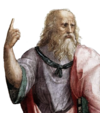觀念論
此條目目前正依照其他维基百科上的内容进行翻译。 (2020年7月10日) |
| 系列部分之 |
| 柏拉图主义 |
|---|
 |
| 相关条目 |
| 相关分类 |
觀念論或理型論[註 1](英語:idealism,德語:Idealismus,又作theory of Forms 形式理論, theory of Ideas等),是希臘哲學中的一種古老的世界觀和理論,是抽象化世界觀在西方的開始,由柏拉圖總結並論述。近現代學者依據理解不同將其歸類於本體論或知识论的範疇。所謂「理型」或稱「理念」(Form, Ideas)可直譯爲「可見形態」、「外貌」(參見下文中詞源一節),在柏拉圖的理論中指代一種超出自然現象與時間的絕對、不可移存在,而自然存在的物質不過是理型的「近似物」而已[2]。
根据该理论,理型被视作切实存在的实体,而就本体论的层面而言,理型同時也优于感官感受到的現實存在。举例来说,“美丽本身”、“正义本身”、“圆本身”、“人类本身”之类的观念,用理型论的视角看待,不仅只是人类感官知覺到的某种表象,更是客观存在的超验实体。所谓理型并不是感官的感受,而是切实存在的事物,除此之外,它们还是完美的、永恆的。理型是經由易變的感官所觀察到的事物原型,也是其得以存在的先决条件。
柏拉圖在對話錄中並未以本人的口吻論述理型,而是藉助了他筆下包括蘇格拉底在內的角色來探討理型的存在,認爲只有對理型的研究才能帶來知識。然而對於理型論的具體內容學界從未達成共識,而這一辯論至今仍在進行。
語源
[编辑]「理型」一詞譯自古希臘語 εἶδος(eîdos)、ἰδέα(idéa),但在古希臘語中並非專門創造的哲學術語,而是日常語言的一部分,代表事物的「外貌」與「可見形態」[3]。這兩個詞的語源都是動詞不定式 ἰδεῖν,代表「看」;來自原始印歐語詞根 *u(e)id- 「看、知」(同源詞包括拉丁語 videō)[4]。然而,柏拉圖將這兩個詞的本來含義逆轉過來,將「可見形態」變成了無法在自然中看到的一種存在;如果說柏拉圖認爲人可以「看到」理型,那麼這種「看」並不是感官在物質世界中所見,而是一種靈魂的、精神的觀察。「以靈魂、精神觀察理型」這一思想在柏拉圖哲學中佔有中心地位[5]。
形式(Form)
[编辑]形式出現於柏拉圖對話錄與演講中,認為現實中的每個個物或性質都有其獨特的理型存在,舉例來說:「狗」有「狗的形式」、山有「山的形式」而「善」有「善的形式」存在。[6]萬物在本質上都是各種不同的形式,而人在現實中所看到「現象」(Phenomena)僅僅只是一種類似於理型的陰影;換句話說,現象只是在不同的情況下對於理型的描繪,而非事物的理型本身。理型也是事物的核心概念或稱本質,舉例來說:世界上有無數張桌子,而所有的桌子都共享桌子的「理型」作為其核心,當沒有理型時事物便不存在。
同時,相對於現實事物的易變、生滅,理型論中的理型是一種永恆、完美且無條件的存在,且存在於一個相對於現實世界的「理型世界」之中,當人的靈魂處在輪迴階段且尚未進入肉體前,就是存在於理型世界中了解現實中不同事物的理型(參見「回憶說」),當降生到人世間後才開始回憶、臨摹完美的理型。除此之外,理型亦為非空間性(aspatial)、非時間性(atemporal),亦即超出空間、超出時間,因為在柏拉圖世界中,理型並非被時間與空間所規範,因此沒有所謂時間意義上的的開始與終結,也沒有空間維度、方向與位置。相反地,理型提供了時間與空間本身存在的基礎,而在現實界之中,理型甚至超越物質與心靈。[7][8][9][10]
註釋
[编辑]引用
[编辑]- ^ Diogenes Laertius, 3.15.. [2020-07-10]. (原始内容存档于2014-04-28).
- ^ Watt, Stephen. "Introduction: The Theory of Forms (Books 5-7)". Plato: Republic. London: Wordsworth Editions. 1997: xiv–xvi. ISBN 1-85326-483-0.
- ^ εἶδος in Liddell and Scott; ἰδέα in Liddell and Scott.
- ^ Robert Beekes. Etymological Dictionary of Greek, Vol. 1. Leiden: Brill. 2010: 577. ISBN 978-90-04-17420-7.
- ^ Christian Schäfer: Idee/Form/Gestalt/Wesen. In: Christian Schäfer (Hrsg.): Platon-Lexikon, Darmstadt 2007, S. 157–165, hier: 159–161.
- ^ Baofu, Peter (2011). Beyond Ethics to PostEthics: A Preface to a New Theory of Morality and Immorality. Charlotte, NC: IAP. p. 131. ISBN 978-1-61735-311-6.
- ^ Mammino, Liliana; Ceresoli, Davide; Maruani, Jean; Brändas, Erkki (2020). Advances in Quantum Systems in Chemistry, Physics, and Biology: Selected Proceedings of QSCP-XXIII (Kruger Park, South Africa, September 2018). Cham, Switzerland: Springer Nature. p. 355. ISBN 978-3-030-34940-0.
- ^ The creation of the universe is the creation of time: "For there were no days and nights and months and years ... but when he (God) constructed the heaven he created them also." – Timaeus, paragraph 37. For the creation God used "the pattern of the unchangeable," which is "that which is eternal." – paragraph 29. Therefore "eternal" – to aïdion, "the everlasting" – as applied to Form means atemporal.
- ^ Space answers to matter, the place-holder of form: "... and there is a third nature (besides Form and form), which is space (chōros), and is eternal (aei "always", certainly not atemporal), and admits not of destruction and provides a home for all created things ... we say of all existence that it must of necessity be in some place and occupy space ...." – Timaeus, paragraph 52. Some readers will have long since remembered that in Aristotle time and space are accidental forms. Plato does not make this distinction and concerns himself mainly with essential form. In Plato, if time and space were admitted to be form, time would be atemporal and space aspatial.
- ^ These terms produced with the English prefix a- are not ancient. For the usage refer to They are however customary terms of modern metaphysics; for example, see and see
